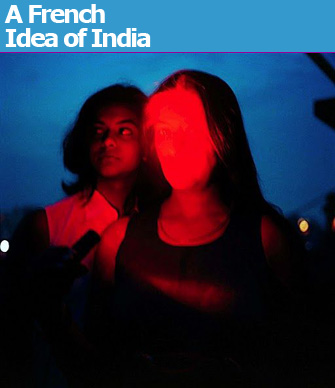 |
|
From Dayanita Singh’s installation “House of Love” (2010). © Courtesy of the artist, Nature Morte, New Delhi and Firth Street Gallery, London |
The stated goal of the exhibition “Paris-Delhi-Bombay” is to “generate exchanges and create lasting links between …
 |
|
From Dayanita Singh’s installation “House of Love” (2010). © Courtesy of the artist, Nature Morte, New Delhi and Firth Street Gallery, London |
The stated goal of the exhibition “Paris-Delhi-Bombay” is to “generate exchanges and create lasting links between the two cultures” of France and India, and to show how today’s India is perceived by Indian and French artists. To what purpose is not clear, but I suppose it’s as good an excuse for an exhibition as any. Why the title mentions Delhi and Bombay is another mystery, since the show is supposed to be about the entire country; a better name might have been “A Certain Idea of India,” the title of a book by Alberto Moravia cited by one of the contributors to the exhibition’s catalogue.
Judging by the number of Frenchwomen visiting the exhibition dressed in Indian garb the other day (okay, there were only three, but that’s far more than you would see in Paris on an ordinary day – were they planted by the Centre Pompidou?), there are already plenty of links between France and India.
The show makes its social concerns clear from the start by opening with a “documentation center” meant to educate ignorant Westerners on six topics concerning India: politics, urban development and the environment, religion, home, identity and craft production. The information on each topic, summed up in a few paragraphs and illustrated with a few videos and statistics, is necessarily cursory and reductive. I read it all, and there was little there I didn’t already know from general reading.
Then comes the art, provided by nearly 50 French and Indian artists “inspired” by these themes. Some of it is political in nature and much is less than prepossessing. Inevitably, Subodh Gupta, an Indian artist whose work is very popular in French contemporary art shows, is included. Once you have seen one of his installations consisting of accumulations of huge numbers of stainless-steel utensils, however, you have pretty much seen them all. French duo Pierre et Gilles, whose aesthetic corresponds so well to the that of India, make an appearance with a room-sized installation of glittery, kitschy, Indian-inspired photos new and old.
Amusingly, contrarian French artist Stéphane Calais admits in a text accompanying his large abstract ink drawings that he did not go to India to find inspiration for the work commissioned for this show but stayed in France, not because of the “overwhelming” nature of the subject but because he wanted to avoid a tourist’s-eye view of the country and resist the temptations of folklore. His contribution to the show is one of the few that ignores the vibrant colors often associated with India.
One of the stronger works in the show is Jitish Kallat’s “Ignitaurus,” the terrifying “skeleton” of a hybrid bull/motorcycle, its forefeet raised on a gold footstool. Other pieces I particularly appreciated were Leandro Erlich’s “Le Regard,” an installation consisting of an extremely elegant (because fitted out by top Parisian interior decorator Jacques Grange) Parisian bedroom, with one tall French window looking out on the real view of Paris, dominated by the Sacré Cœur, and the other onto a filmed street scene in Bombay.
Gilles Barbier offers an immense and complicated installation, “The Game of Life,” in which the playing pieces are dwarf-sized clones of his own bald-headed self in various costumes – Superman, kimono, court jester, etc. – posed in a strange garden littered with banana peels and the occasional human brain. This conceptual piece, in which the artist looks back on his own career, has the added virtue of being intriguing even when you don’t know the concept behind it.
Jean-Michel Othoniel contributes a beautiful colored-glass instrument/sculpture. A recording of a piece composed for it by Mauro Lanza can be heard while you look at the piece.
For “Silence (Blood Wedding),” Anita Dube has transformed human bones into pretty baubles and fetishistic objects by covering them with red velvet and decorating them with lace and pearls.
One of my favorites works was Dayanita Singh’s installation of 42 haunting photos displayed in a darkened room. While each has a different subject, they all share a striking use of light.
A few of the Indian artists broach the taboo (in India) topic of sex in their work, and Sunil Gupta goes so far as to create a “photo novel” called “Sun City” (after a gay sauna in Paris where part of it was shot) about an Indian man who goes to Paris to visit his French lover and spends his nights in a colorful bathhouse.
One irritating aspect of the exhibition is the condescending way the labels accompanying each piece not only explain how and why it was made but also tell you how to interpret it. “This work is designed to trick the eyes and mind,” says the label for Sunil Gawde’s “Virtually Untouchable – III,” pretty garlands of flowers made of red-painted razor blades, adding that it explores “the concept of the duality of existence in which beauty and innocence cohabit with danger and death.” Thanks for explaining that – I might have cut myself.
Centre Pompidou: 19, rue Beaubourg, 75004 Paris. Tel.: 01 44 78 12 33. Open 11am-9pm. Closed Tuesday. Métro: Rambuteau. Admission: €12. Through September 19. www.centrepompidou.fr
Reader Reaction: Click here to respond to this article (your response may be published on this page and is subject to editing).
Please support Paris Update by ordering books from Paris Update’s Amazon store at no extra cost. Click on your preferred Amazon location: U.K., France, U.S.
More reviews of Paris art shows.
© 2011 Paris Update
Favorite